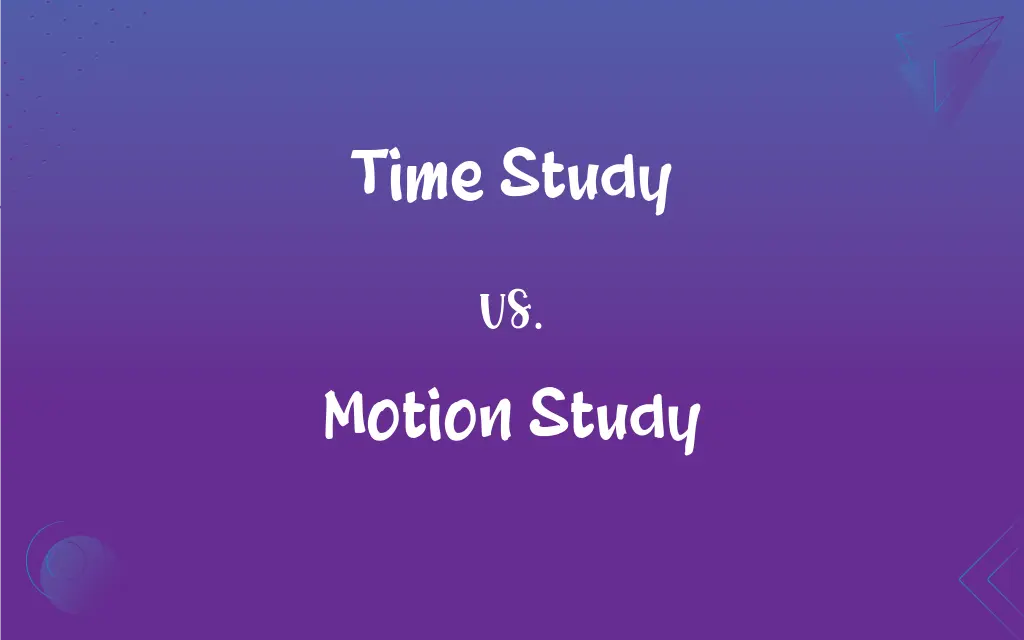Time Study vs. Motion Study: What's the Difference?
Edited by Aimie Carlson || By Harlon Moss || Published on November 15, 2023
Time study analyzes task duration; motion study examines actions to improve efficiency.

Key Differences
Time study and motion study, while often used interchangeably in industrial settings, serve different yet complementary purposes in optimizing workplace efficiency. A time study primarily focuses on measuring the time required for a worker to complete a specific task or series of tasks, thereby establishing standard times for activities. Conversely, a motion study delves deeper into the movements involved in a task, analyzing each motion to identify and eliminate unnecessary movements. While time study concentrates on the duration of work, motion study scrutinizes the nature and quality of the motions employed, offering a microscopic view of the task at hand.
In the realm of productivity improvement, time study and motion study offer unique lenses through which work processes can be examined. Time study is instrumental in establishing baselines for performance and identifying variations in the time taken to complete tasks, making it crucial for setting realistic targets and expectations. On the other hand, motion study brings an ergonomic perspective, focusing on how a task is performed. This study aims to redesign tasks for greater efficiency and reduced strain, ensuring that each motion is purposeful and contributes to the overall efficiency of the task.
While both time study and motion study are integral to process optimization, they approach the task from different angles. A time study might reveal that a particular task takes longer than anticipated, prompting further investigation. However, it is the motion study that often provides the insights needed to understand why the task takes that long, by breaking down and analyzing each movement involved. Therefore, while time study flags potential inefficiencies based on time metrics, motion study digs into the root causes of these inefficiencies at the level of individual motions.
The methodologies employed in time study and motion study also differ, reflecting their distinct focuses. Time study typically involves the use of stopwatches or time recording devices to measure the duration of tasks, often repeated multiple times for accuracy. Motion study, on the other hand, might utilize video recording or motion capture technology to meticulously observe and analyze every movement a worker makes. While time study quantifies the temporal aspect of work, motion study provides a qualitative analysis of the physical actions involved in a task.
In summary, time study and motion study are critical tools for operational excellence, each playing a unique role in workflow optimization. Time study is geared towards quantifying how long tasks take and setting performance standards, whereas motion study aims to improve the way tasks are performed by analyzing and optimizing each movement. Both are essential for a comprehensive understanding of workplace efficiency, and when used in conjunction, they can significantly enhance productivity and worker well-being.
ADVERTISEMENT
Comparison Chart
Primary Focus
Measuring task duration.
Analyzing and improving physical actions.
Goal
Establish standard times for tasks.
Optimize movements for efficiency.
Tools Used
Timing devices like stopwatches.
Video recording, observation techniques.
Application in Workflow
Improves planning and scheduling.
Enhances ergonomics and reduces wasteful movements.
Historical Development
Originated from Frederick Taylor's work.
Developed by Frank and Lillian Gilbreth.
ADVERTISEMENT
Time Study and Motion Study Definitions
Time Study
Analysis of time taken for tasks.
The time study revealed inefficiencies in the process.
Motion Study
Analysis of work motions for efficiency.
A motion study was conducted to reduce worker fatigue.
Time Study
Measurement of task duration.
They conducted a time study to establish standard operating times.
Motion Study
Method to optimize work motions.
The assembly line was redesigned after a motion study.
Time Study
Method for analyzing work time.
The time study helped in scheduling workers more effectively.
Motion Study
Examination of physical movements in tasks.
The motion study led to ergonomic improvements.
Time Study
Technique for assessing time usage.
The manufacturing plant utilized a time study for better resource allocation.
Motion Study
Technique for improving physical tasks.
The motion study resulted in faster and safer operations.
Time Study
Process of timing work activities.
A time study was used to improve productivity.
Motion Study
Study of actions to enhance productivity.
Through motion study, they eliminated unnecessary movements.
FAQs
Is time study used for cost estimation?
Yes, it helps in accurate labor cost estimation.
How does a motion study help workers?
It improves ergonomics and reduces unnecessary movements.
Can time study be used in any industry?
Yes, it’s applicable across various sectors.
What’s the purpose of a time study?
To measure and standardize the time needed for tasks.
Can a time study help in employee scheduling?
Yes, it’s useful for effective scheduling and planning.
Is time study important for setting performance standards?
Yes, it’s crucial for establishing performance benchmarks.
Does motion study affect worker satisfaction?
It can improve satisfaction by reducing strain and fatigue.
Does time study take into account breaks and delays?
Yes, these factors should be included for accuracy.
Does motion study contribute to safety?
Yes, it can enhance workplace safety by optimizing movements.
Can motion study lead to job redesign?
Yes, it often results in redesigned jobs for better efficiency.
Is motion study related to ergonomics?
Yes, it’s closely related to ergonomic improvements.
Do motion studies apply to manual tasks only?
Primarily, but they can also apply to some automated processes.
Can motion study reduce labor costs?
Yes, by increasing efficiency and reducing time wastage.
Are there modern software tools for time study?
Yes, there are various modern digital tools and software.
Can motion study be self-conducted by workers?
It’s possible, but expert analysis often yields better results.
Is motion study useful in automating processes?
Yes, it can inform automation for improved efficiency.
Is a time study a one-time process?
It may need to be repeated as processes and technologies evolve.
How long does a motion study typically take?
It varies depending on the complexity of tasks.
Can time study identify bottlenecks?
Yes, it’s effective in pinpointing process bottlenecks.
Does time study require specialized equipment?
Basic timing devices are usually sufficient.
About Author
Written by
Harlon MossHarlon is a seasoned quality moderator and accomplished content writer for Difference Wiki. An alumnus of the prestigious University of California, he earned his degree in Computer Science. Leveraging his academic background, Harlon brings a meticulous and informed perspective to his work, ensuring content accuracy and excellence.
Edited by
Aimie CarlsonAimie Carlson, holding a master's degree in English literature, is a fervent English language enthusiast. She lends her writing talents to Difference Wiki, a prominent website that specializes in comparisons, offering readers insightful analyses that both captivate and inform.






































































